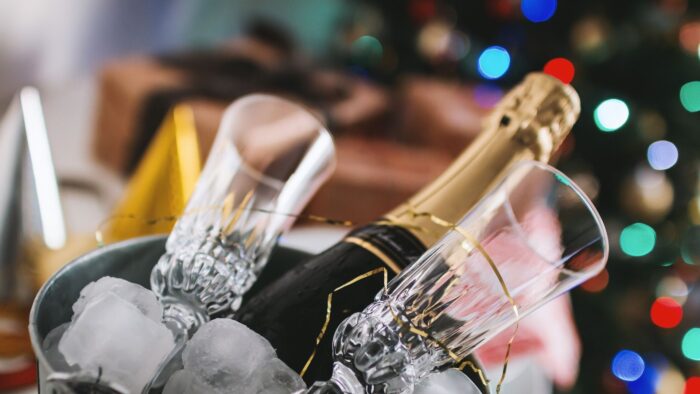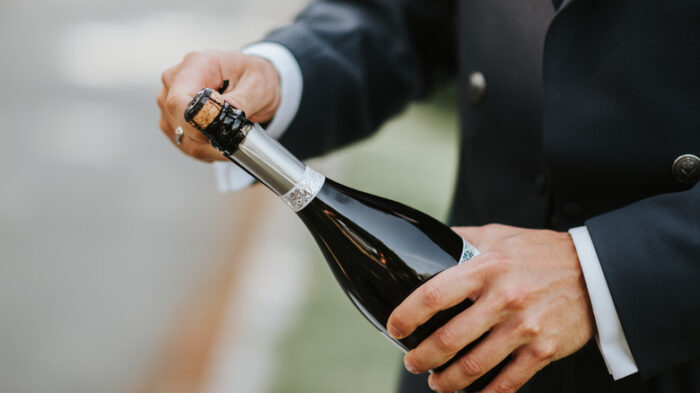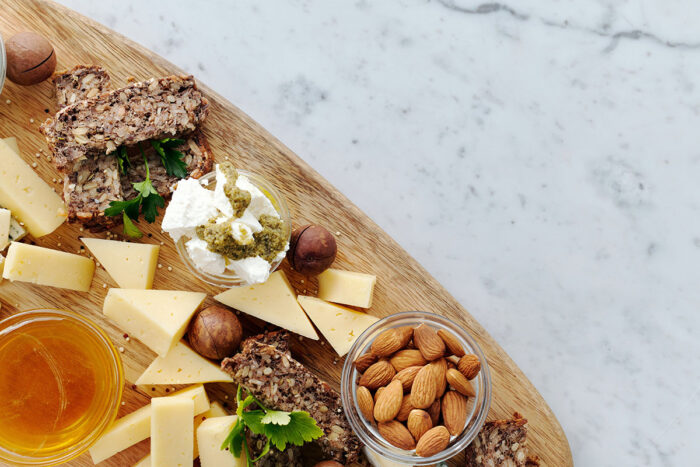
Sparkling wine, with its effervescent charm and celebratory spirit, has earned its place as a favorite choice for toasts and special occasions. Whether it’s Champagne, Prosecco, Cava, or any other sparkling wine, knowing how to serve it properly enhances the overall experience.
In this article, we will explore the art of serving sparkling wine, from selecting the right glassware to achieving the perfect serving temperature and pairing it with delicious accompaniments.
The significance of choosing the appropriate glassware for serving sparkling wine cannot be overstated. The right glass enhances the overall sensory experience, from visual appeal to aroma and taste. Here’s a more comprehensive exploration of the subject:

Flute Glasses: Flute glasses, with their tall, slender design and narrow opening, are the quintessential choice for serving sparkling wine. These glasses are specifically crafted to showcase the wine’s effervescence and preserve its bubbles. The elongated shape allows the bubbles to rise gracefully, creating a mesmerizing display while maintaining the wine’s carbonation. Moreover, the narrow opening concentrates the wine’s aromas, enhancing your ability to appreciate the bouquet. Flute glasses are the preferred choice for Champagne, as they highlight its complexity and elegance.
Tulip-Shaped Glasses: Tulip-shaped glasses are another excellent option for serving sparkling wine. They share similarities with flute glasses but have a slightly wider bowl and a gently tapering top. This design provides more room for the wine to aerate, allowing the aromas to develop further. Tulip glasses are versatile and can be used for a variety of sparkling wines, including Champagne, Prosecco, Cava, and Franciacorta. They offer an excellent compromise between the elegance of flutes and the aroma-enhancing qualities of wider glasses.
Coupe Glasses: Although less common today, coupe glasses were historically used for serving sparkling wine, especially in the early 20th century. These shallow, wide-bowled glasses are known for their vintage charm. However, they are not the preferred choice for sparkling wine because their wide surface area allows the bubbles to dissipate quickly. As a result, the effervescence and aromas may not be as pronounced as in flute or tulip glasses.
When choosing the right glassware, consider the type of sparkling wine you are serving and the experience you want to create. While flute and tulip glasses are the recommended choices for most sparkling wines due to their ability to enhance the wine’s characteristics, it’s also essential to choose glassware that aligns with your personal preferences and aesthetics.

Optimal Serving Temperature
The temperature at which you serve sparkling wine is not just a minor detail; it can significantly impact the wine’s taste, aroma, and overall enjoyment. The key to serving sparkling wine at its best lies in finding the ideal temperature for each specific type. Here’s a more detailed breakdown:
Crémant: Crémant wines, produced in various regions of France, should be served at a slightly cooler temperature, typically between 40-45°F (4-7°C). This range highlights their finesse and elegance while preserving their delicate bubbles.
Prosecco: Prosecco is best served slightly cooler, between 40-45°F (4-7°C), to highlight its crispness and fruity notes.
Franciacorta: If you’re enjoying a bottle of Franciacorta, an Italian sparkling wine made using the traditional method, it is recommended to serve it at approximately 45-50°F (7-10°C). This temperature range allows Franciacorta to showcase its elegant and nuanced characteristics, similar to Champagne.
Champagne: Serve Champagne at around 45-48°F (7-9°C). This temperature allows you to appreciate its complex aromas and flavors fully.
To achieve the correct serving temperature, start by placing the bottle in a refrigerator for several hours. Once it’s sufficiently chilled, consider using an ice bucket to maintain the temperature as you serve. However, be cautious not to over-chill the wine, as excessively cold temperatures can mask the wine’s complexities and diminish the overall experience.
Remember that serving sparkling wine at the right temperature is essential for fully appreciating its nuances, effervescence, and bouquet. It showcases the craftsmanship of the winemaker and ensures that every sip is a pleasurable journey through the world of bubbles. Whether you’re raising a glass for a special occasion or simply enjoying a casual evening, serving your sparkling wine at the optimal temperature will elevate the experience and leave a lasting impression.

Opening the Bottle
Opening a bottle of sparkling wine can be a moment of anticipation and excitement. Here are the steps to ensure a smooth and safe bottle opening:
- Remove the foil: Start by carefully removing the foil capsule, ensuring you don’t disturb the cork underneath.
- Loosen the wire cage: While holding the cork, gently untwist and loosen the wire cage. Be cautious, as the cork is under pressure.
- Keep your thumb on the cork: Place a clean cloth or napkin over the cork, holding it securely with your thumb while keeping the bottle pointed away from people and fragile objects.
- Twist the bottle, not the cork: With one hand holding the cork and the other hand firmly gripping the bottle’s base, gently twist the bottle to release the cork slowly and with a quiet “pop.”
- Pouring: When pouring sparkling wine, aim to fill the glass halfway initially to allow room for the bubbles to rise without overflowing.
Presentation and Serving
Sparkling wine is all about presentation and making a statement. Here’s how to serve it in style:
- Hold the glass by its stem to prevent your hand from warming the wine prematurely.
- Pour the wine gently, allowing it to slide down the side of the glass to preserve its effervescence.
- Fill the glass to about two-thirds full to leave room for the aromas to develop and to enjoy the visual appeal of the rising bubbles.
- If serving multiple guests, pour each glass individually rather than filling all at once to ensure freshness.

Pairing with Accompaniments
Pairing sparkling wine with the right food can elevate both the wine and the dining experience. Here are some classic pairings:
- Oysters: The briny freshness of oysters complements the crisp acidity of sparkling wine.
- Caviar: The salty, creamy richness of caviar pairs wonderfully with the effervescence and acidity of sparkling wine.
- Cheese: Soft cheeses like brie or camembert and hard cheeses like Parmesan or Gouda make excellent companions to sparkling wine.
- Light appetizers: Sparkling wine goes well with a variety of light appetizers such as smoked salmon, sushi, and seafood dishes.
- Desserts: Sparkling wine can be enjoyed with desserts like fruit tarts, sorbets, and delicate pastries.
Conclusion
Serving sparkling wine is an art that involves choosing the right glassware, achieving the perfect serving temperature, opening the bottle with care, and pairing it with delectable accompaniments. By following these guidelines, you can ensure that every glass of sparkling wine you serve is a delightful and memorable experience, perfect for toasting life’s special moments. So, next time you uncork a bottle of bubbly, do it with confidence, and raise your glass to the joy of sparkling wine!





